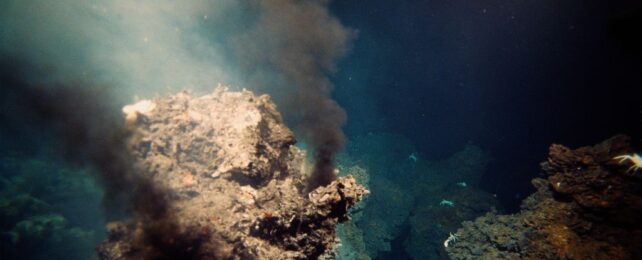The cloudy material that drifts from chimney-like vents in the ocean floor could harbor microscopic lifeforms scientists never even knew existed.
The ridges of the ocean seabed are littered with fissures called hydrothermal vents that spew hot, deep-Earth fluids containing hydrogen sulfides, methane, and hydrogen out into the ocean.
Around the warm periphery of these dynamic nutrient dispensers huddle a whole bunch of hungry and mysterious microbes that use the chemicals diffusing from the vent to thrive in the absence of sunlight or ample oxygen.
But those might not be the only niches provided by the vents in which microbes eke out an existence.
A new study has now identified a genus called Sulfurimonas, that can not only flourish around hydrothermal vents, it can also live in the colder and more oxygenated plumes spilling out above.
These smoky clouds can stretch upwards by hundreds of meters and outwards by kilometers. They occur when hot magma mixes with cold seawater, and comprise of an entirely different menu of chemicals to the hydrothermal vents from which they spring.
Sulfurimonas is known to be a dominant player around hydrothermal vents, easily surviving in warm and oxygen-depleted water and using the sulfide emitted from the vents for energy, but these new findings suggest some species evolved to actually rise with the plumes.
Previous studies have sampled the tops of hydrothermal plumes and found genetic signs of Sulfurimonas, but the bacteria were not thought to actually grow in the cloud. The plumes were believed to be too cold and saturated with oxygen.
"It was assumed that [the bacteria] were flushed there from seafloor vent-associated environments," explains marine microbiologist Massimiliano Molari from the Max Planck Institute in Germany.
"But we wondered whether the plumes might actually be a suitable environment for some members of the Sulfurimonas group."
Sampling hydrothermal plumes is complicated work. It requires expeditions to remote parts of the ocean, where the boundaries of tectonic plates are gradually pulling apart.
These regions are not easy to locate, and even when they are found, sampling the hydrothermal plume is tricky when it lies more than 2,500 meters (around 8,200 feet) below Arctic sea ice or the white caps of rough waves.
The current study is the first to directly test whether the tops of these plumes provide a suitable habitat for Sulfurimonas.
The sampling occurred in the central Arctic Ocean and also along the South Atlantic Ocean.
Genome sequencing revealed one particular species, called Sulfurimonas pluma, which was "globally abundant and active in cold (less than 0 to 4 degrees Celsius), oxygen-saturated and hydrogen-rich hydrothermal plumes".
Unlike other species of Sulfurimonas, S. pluma's genome showed signatures of an aerobic metabolism, which relies on oxygen to grow.
The bacterium also seems to have lost the ability to reduce nitrate, which is what the genus usually uses instead of oxygen when living around hydrothermal vents.
Further studies are needed to figure out which metals and compounds favor S. pluma's growth within the near-freezing plumes of drifting material, but according to the new results, this seems to be a suitable environment for the bacteria to live and reproduce.
Other signs of bacteria within hydrothermal plumes are thought to have come from the surrounding seawater and not from hydrothermal vents. This could be true of S. pluma, but it could also be the case that this bacterium is a 'transition' species. It could explain how some of the ocean's oldest lifeforms (possibly more than 4 billion years old) evolved to drift away from hydrothermal vents and make their home elsewhere.
"We think that the hydrothermal plume does not only disperse microorganisms from hydrothermal vents, but it might also ecologically connect the open ocean with seafloor habitats," says Molari.
"Our phylogenetic analysis suggests that Sulfurimonas pluma could have derived from a hydrothermal vent-associated ancestor, which acquired higher oxygen tolerance and then spread across the oceans."
Molari and his colleagues say their findings have opened "new paradigms in the microbial ecology" of the sea, revealing a novel niche for an abundant bacteria that is found in oceans all around the world.
The study was published in Nature Microbiology.
